Mornings on Fair Oaks Bridge – Introduction
This segment describes what you will hear in the series of 12 podcasts. Each one describes Janice’s early morning experiences and settings, beginning in September 2016 continuing through February 2018.
Janice Kelley
Sharing Stories Focused on Sense of Place, People and Purpose
This segment describes what you will hear in the series of 12 podcasts. Each one describes Janice’s early morning experiences and settings, beginning in September 2016 continuing through February 2018.
Gulls gather on the river in groups of a hundred or more to wait for salmon to swim upstream, spawn and die. Turkey vultures and salmon both guard their catch.
Watching a flock of hungry seagulls gathered at an island at the American River during the fall salmon run.
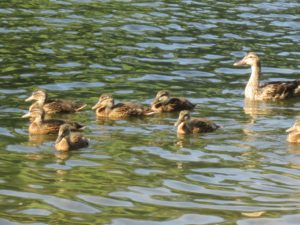 As I stand looking at the river, I see a man that could be a grandfather walking with his young grandson. My mind instantly wanders. I wonder what lies ahead for salmon in this boy’s lifetime? What is the future for all wildlife that depends on the health of the American River – and rivers everywhere when the morning begins as a new day.
As I stand looking at the river, I see a man that could be a grandfather walking with his young grandson. My mind instantly wanders. I wonder what lies ahead for salmon in this boy’s lifetime? What is the future for all wildlife that depends on the health of the American River – and rivers everywhere when the morning begins as a new day.
I see cyclists crossing the Hazel Avenue Bridge – a newly expanded and modernized bridge to accommodate additional cars. I see a complex network of structures – a bridge for cars and bicycle trails, the dam on one side and the weir on the other. Looking at this network reminds me that I am still in an urban area congested with traffic, people, businesses, retailers and a host of other community services and amenities. This place is less than 20 miles from city, county and state government leaders who make long term decisions that affect the health of this river and all other California rivers.
These intersections on the river where salmon come home, cyclists ride, and people drive, is part of the larger story of our environmental challenges – water supply, climate change, urbanization, noise and sustaining healthy habitats. Yet, here where the salmon come home presents so many opportunities to inform, educate and inspire positive change.
Drizzle rain stops and starts again. Still very few people outside at 11 am. A warm rain. River is very quiet with cloudy skies and no rain. Ducks search the river for food, wings flap. Faint quacks. Canada geese change position and fly away. A cloudy sky and all is quiet. Boaters sit calmly in the water. The gentle, nourishing rain is a refreshing and welcome change.
Earlier boaters in their rain jackets have sped away heading east toward the weir positioned at the Nimbus Fish Hatchery where the salmon converge to spawn – either in the river or inside the hatchery. Birds patrol the sky. Turkey vultures wait patiently, ready to pounce on whatever has died. I find salmon heads cast off into the rocks. Soon these remains will be consumed by hungry turkey vultures, seagull or other wildlife that find them first.
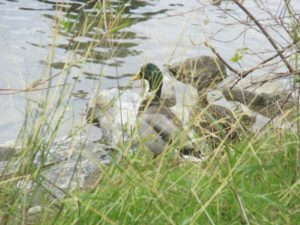
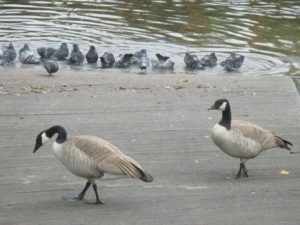
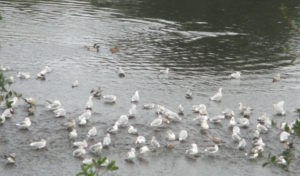 As I arrive on my bike at the Fair Oaks Bridge, I see a flock of 50 seagulls gather on the north side of the river. More fly in to join them.
As I arrive on my bike at the Fair Oaks Bridge, I see a flock of 50 seagulls gather on the north side of the river. More fly in to join them.
Seagulls gather at two prime locations along the river waiting for their chance to nibble on remnants of salmon after spawning. Turkey vultures circle overhead. All looking for salmon.
The river’s resident egret flies in, squawks and lands on the smooth riverbank searching for food. The wildlife living at the American River are left alone with no fishing allowed. A few salmon jump and splash down. A warm day for riding, despite the cloud cover.
I wonder is the fish ladder open yet? I ride to the Nimbus Fish Hatchery to find out. Yes! Salmon have returned home. Salmon are leaping into the ladder from the open gate. A group of salmon all already crowding the holding tank at the top of the fish ladder – the last stop before salmon move into the hatchery for spawning. Crowds of people line the fish ladder to watch each salmon leap each one level upward and capture the moments in photos.Read more
Today I ride along the bike trail to watch the salmon traveling upstream. I stand watching them for half an hour, seeing a series of splashes beginning 100 yards away and getting closer. This shallow part of the river presents the richest experience for watching salmon, seagulls and turkey vultures overhead. As I stop to watch a dozen other cyclists and walkers also stop to enjoy the salmon navigating the river and the seagulls looking for their next meals.
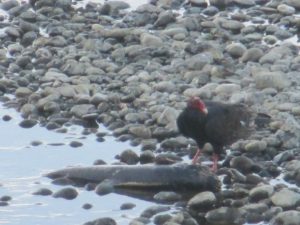
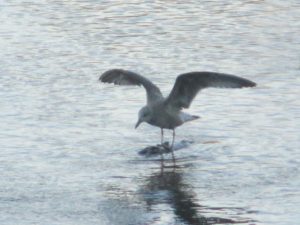
Hundreds of seagulls line the river, some walk into the rapids, stand, shout and wait. Thirty turkey vultures fly overhead – more than I have ever seen in one place at one time. I watch as a dozen salmon leap, swim, gather, rest and move on through the rapids to still water.
One dead salmon rests on rocks in the center of the rapids. One at a time, a seagull approaches. It pokes his beak around, pondering what to do and then nibbles on parts of salmon’s underside. One seagull sits in the water near the shore where I stand, open its beak wide and calls to the others, whoever will listen. I watch and I listen as the seagulls stretch their wings before returning to settle in the water. A few ducks swim in the quiet pool of water, apparently unconcerned about the activity.
This narrow section of the river is the same where I watched ducks station themselves to search for food in the water a few weeks ago. Now this is dominated by the salmon and the gulls. The coming of the salmon quickly changed the interaction of wildlife at the river.
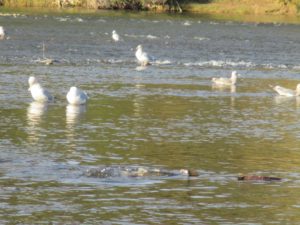
I ride east to another overlook where hundreds more gulls line up and wait. This section of the river is far wider and the only sound is the water moving downstream. Seagulls are silent. No turkey vultures fly overhead. The only clue that this river winds through a suburban community is the houses located on the Fair Oaks Bluffs above.
The tip of the thin island where the fisherman used to stand is now even smaller because with increased river flows, the island is thin enough to almost disappear. The gulls have overtaken this space as they wait.
April 30, 2017, 6:30 pm 85 degrees
Visitors crowd the Fair Oaks Bridge taking professional photographs using the American River as a scenic backdrop. The riverbanks are crowded with people enjoying picnic dinners. All people, no wildlife.
As I arrive at the cement bench that has been sitting on its back all year (and shown in my latest blog). The bench is upright again! Did someone read my post or is this an odd coincidence?

I ride on and sit at the riverbank and picnic area where in the fall I watched 100 seagulls, on the opposite shore to my right, wait for salmon to come by and ducks swim, splash and dive near an island to my left. Now the river is running so high, all the islands are underwater and unseen, the waterfowl have moved somewhere else along the river corridor. This section is far too deep and moving too swiftly to find food.
Six Canada geese fly over and disappear as they fly further west. As I prepare to leave the shoreline and keep riding on, I see a Great Blue Heron appear over the water and continue its flight further west. My first sighting of the year!
Waterfowl are here…where to look remains the big question.
Friday, August 11, 2017 845 am 68 degrees
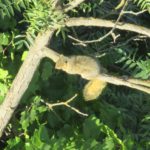
They join a dozen other ducks already scouting breakfast on the rocky shoreline. True to their nature the geese are late arrivals for the morning ritual. Squirrels are busy finding their breakfast in the trees.
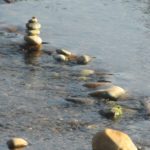
During a quick trip to the boat launch ramp, I see no waterfowl anywhere. No fishing boats sitting in the American River. Today I continue my ride east toward the Nimbus Fish Hatchery. This is the prime salmon spawning area come late September through early December. I used to see a dozen ducks bobbing in shallow rapids for food as I ride by. None today.
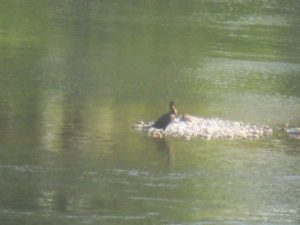
I arrive at the picnic area at the river’s edge, far off the bike trail, where last fall I saw 100 seagulls feasting on dead salmon. The small island located in the middle of the river channel that was big enough for fisherman to anchor their boats and stand alongside them in hip deep water is now two thin and barely visible stretches of rocks.
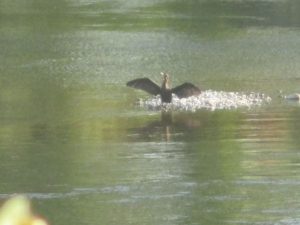 I spy a cormorant sitting on a rocky island hanging its wings to dry in the early morning air. It stands motionless for 10 minutes before flying away. I see ducks hide alongside green shrubbery of a nearby island jutting out from the western riverbank.
I spy a cormorant sitting on a rocky island hanging its wings to dry in the early morning air. It stands motionless for 10 minutes before flying away. I see ducks hide alongside green shrubbery of a nearby island jutting out from the western riverbank.
Except for an occasional distant quack from a lone duck, this area is quiet today. Here I am far away from homes hanging on the Fair Oaks Bluffs, traffic and people congregating on shorelines. I hear a distant hum from another roadway bridge alongside the fish hatchery, less than a mile and completely out of sight.
With no homes on the opposite shore, I see a mix of oaks, shrubs and grasslands. I could say they are in a natural and undisturbed state. Little along the river channel was left untouched during winter floods. Remnants are still visible everywhere along the river.
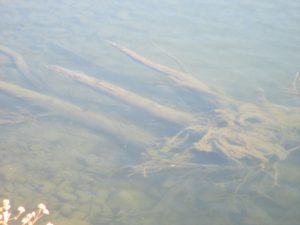
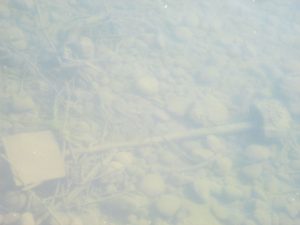
Sunday, October 15, 2017 7am 46 degrees
Mornings are much cooler now, well into October. I am surprised it has not rained yet.
Usually it rains the weekend we decorate our home with outdoor Halloween decorations. I wear jeans, long sleeve shirts, long socks, and a jacket or sweatshirt on my morning visits. My hands are chilled. I have yet to put my gloves on. Mist covers my windshield and the moist air stays on. Despite the cold, people are out walking their dogs.
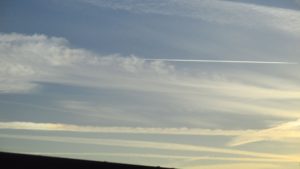
Standing on Fair Oaks Bridge, I see white jet streams crossing the sky leaving a pattern of stripes across a pale blue sky. Today, no visible trace of gray smoke, yet my head remains congested in response to the poor air quality from so many fires some 90 miles north.
This morning, as all mornings, the same small, skinny chicken calls out “I am awake” in chicken speak and scratches the dirt to find breakfast. I can hear it call all morning from the center of Fair Oaks Bridge.
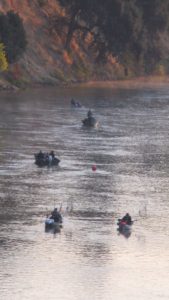
Two young adults are huddled in a blanket are engaged in vibrant conversation as they point to photos in an album. They continue to review their photos all the time I stand on the bridge and do not see them looking at the water or the landscape. Fair Oaks Bridge and the American River underneath create a space for so many different activities. Watching the sunrise, sunset, fishing, running, walking, cycling, kayaks, nature observation, feeding wildlife and picking berries.
When I arrive a cluster of fishermen sit in boats on the American River as if they were holding conference. I wonder if these are same people out every day or if different ones show up. Unlike the woman I encountered last visit who screamed down to them waving a flier about her lost cat, I leave them alone to watch early morning action on the river.
Today I see my first seagull of the season landing near the boat launch ramp. I smell the faint scent of dead salmon in the air. As November draws closer, seagulls know food is plentiful here and they wait.
Two hungry turkey vultures fly overhead. My first spotting for this season. I saw a dozen of them along the American River last year. More signs the salmon have returned. The seagull takes flight and glides through the air toward the bridge, scanning the water. After circling twice, it vanishes. Far more food lies about half a mile upriver. I wonder if the seagulls will be there yet? I see dozens of seagulls waiting during my bike ride later in the day.
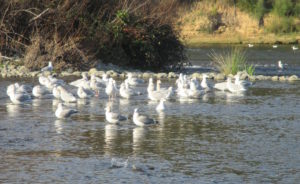
A dozen pigeons approach and land on the bridge overhead Truss frame to rest a while. With the coming of salmon, I expect to see far more salmon jumping and splashing. So far, I see only a few in an hour of watching the river. A Cormorant arrives and flies under the bridge headed west. I follow its flight close to the riverbank and then lose sight as it blends into the distant landscape. Moments later, this elegant bird returns to circle the bridge.
I watch a seagull float gracefully over the bridge and land in the river near the boat launch ramp. Unlike ducks that splash down with wings spread and feet extended as if water skiing, seagulls land sitting down, wings tucked in without a ripple. When I hear the seagull call, I wonder is it calling for others to join? Where is the food? Or locate its flock?
Immediately after hearing the seagull, the lonely chicken calls from Bridge Street. Where else can you hear the call of a seagull and the rousing good morning from a chicken in the same place and time?
I leave the bridge knowing the cooler days of fall and the salmon are here. The wildlife of the American River in fall are ready and waiting.